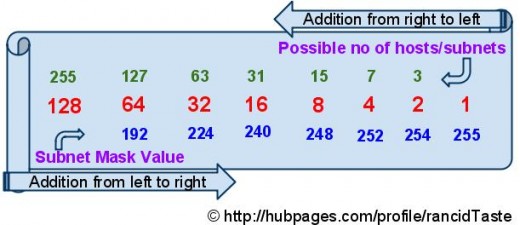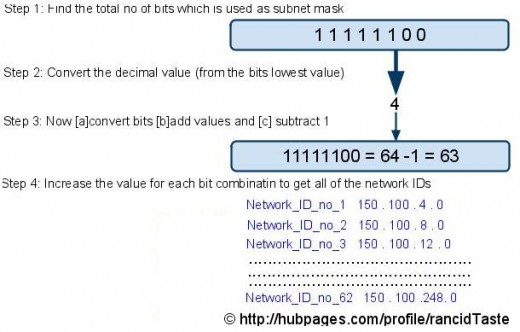Valid Network IDs : The Quickest Way to Define All Valid Network IDs
In Subnet Mask : The Quickest Way to Define Subnet Mask, you have learnt how to define or calculate subnet quickly. This page will describe the quickest way to define all valid network IDs. You will also found some questions on your CCNA exam or your real life job exam. To calculate valid network IDs is very simple. Read the page and you will learn easily, to determine all the valid network IDs.
One thing, I want to remind you again. Please memorize the following chart. I think you have already done. If not, please do it.
[Note: Visit Subnetting Index or type http://hubpages.com/_ccna/hub/Subnet to your browser address bar to learn a-to-z of subnetting. Many examples are there to make you a smart master of subnetting.]

Steps to define all valid network IDs:
- Select the octet (the octet that is used to calculate subnet) and calculate it's decimal value.
- Determine that octet's smallest decimal value also. This value is the incremental value of the networks.
- Calculate the total no of subnets. To do so, [a] first select the subnet octet and convert all the bits (low order) [b] calculate the decimal value of that octet and [c] subtract 1 from the decimal value. In this way, you will find the total no of subnets.
- Now, list each subnet addresses. Start from the IP address and increment by the value (the value you get from step 2) and increase by that value until the total no of available subnets are reached.
Explanation with an Example
Let we have a IP address like 150.100.0.0. We want to find all the valid network IDs. We require 45 individual subnetworks. To do it, we follow the above steps one by one.
Subnet calculation is already explained into Subnet Mask : The Quickest Way to Define Subnet Mask. To see that please go to that link. In this page, the quickest way to define all valid network IDs are explained.
Step 1: Select the octet (the octet that is used to calculate subnet) and calculate it's decimal value.
The subnet mask of this IP starts from third octet. Here, we find the value 11111100 (in binary) and convert it to decimal value. The decimal value of 11111100 is 252.
Step 2: Determine that octet's smallest decimal value also. This value is the incremental value of the networks.
From the subnet octet, the decimal value of the small bits are 4. This value is used for incrementing the networking IDs. Moreover, you will start counting all the value networks by this value and increment the network by this value.
Step 3: Calculate the total no of subnets. To do so, [a] first select the subnet octet and convert all the bits (low order) [b] calculate the decimal value of that octet and [c] subtract 1 from the decimal value. In this way, you will find the total no of subnets.
Calculate the decimal value of the binar address listed in low order.You will find the value = (61-1) = 62. This value, 62 is the total number of valid network IDs of your IP.
Step 4: Now, list each subnet addresses. Start from the IP address and increment by the value (the value you get from step 2) and increase by that value until the total no of available subnets are reached.
From the step to, we calculate that the incremental value will be 4. So, the first subnet address will be 150.100.4.0, the next address will be 150.100.8.0, and so on. All the network IDs are look like the followings:
Network no Network addres
1 150.100.4.0
2 150.100.8.0
3 150.100.12.0
4 150.100.16.0
5 150.100.20.0
.............................
.............................
.............................
.............................
62 150.100.248.0
Shortcuts to determine all valid network IDs

© Written by rancidTaste



